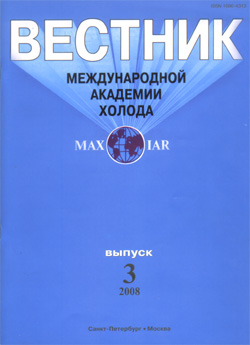
Batch-wise process of cherry juice freeze concentration

Annotation
Basic laws of the cherry juice freeze concentration process are investigated. Is established that the basic factors influencing the process of freezing are: the boiling point of refrigerant in the freezing unit (–17 оС), surface area of heat exchange elements to the unit of the working volume of the unit, the juice flow rate and initial content of dry matter in the original juice. It is shown that with the decrease of the refrigerant boiling point in the vaporizer of the freezing unit specific quantity of the ice frozen out increases monotonically due to the transition of a significant quantity of free water into the solid phase because of the high temperature difference between the circulating juice and the heat exchange surface of the unit. A specific quantity of the ice frozen out with an increase in the specific surface area of heat exchange elements to 72,0…75,0 m2/m3 increases to a certain value also, then it decreases to the maximum values of the compressor refrigerating power. A change in the value of a specific quantity of the ice frozen out depending on the cherry juice flow rate (2·10–5 м3/с) and the initial content of dry matter in it (12,4%) is of nonlinear nature also. The influence of the investigated factors on the energy consumption at moisture freezing out is analyzed. It is found out that with an increase in the specific surface area of heat exchange elements the specific energy consumption to freeze out 1 kg ice increases directly proportionally, reaching maximum value at the maximum specific surface area of heat exchange elements (f = 127 м2/м3). The greatest energy consumption is found to be when a juice with the minimum initial content of dry matter is frozen out. The obtained information is of great importance for estimation and prediction of both the regimes of freezing cherry juice with different content of dry matter and the energy consumption for the heating of the concentration process.
Keywords
Постоянный URL
Articles in current issue
- Prevention of Diabetes through use of Hypoglycemic Chinese Herbs
- Evaluation of meat grinder performance depending on their design and physical and mechanical properties of raw-material
- High temperature sterilization of pear compote with two-stage heating of fruits in SHF electromagnetic field
- Cod liver and its fat in multicomponent food technology
- On the problem of a mathematical model for herring salting process
- Respiration substrates oxidation kinetics of grape for table use at refrigerated storage with track membranes
- Analysis of energy consumption reduction methods in refrigeration systems during year-round exploitation
- Mathematical model of heat balance calculation for the radiator of refrigeration system with effective radiation into space
- Cryoadsorption vacuum pump in pulse mode: operation peculiarities
- Study of short low temperature range heat pipes. Part 2. Theoretical model*
- Systematization of airindependent low-temperature combustion installations
- Increasing gas compressor units energy efficiency
- The influence of cryosphere and cloud cover area of the Earth on its energy balance and global climate
- Curvilinear diameter rule and scaled equation with variables of pressure and temperature
- The comparison of the intensity of heat transfer and pressure drop during boiling of the refrigerants R404A and R22 in horizontal pipes
- Non-uniformity of geothermal well heat pump temperature field
